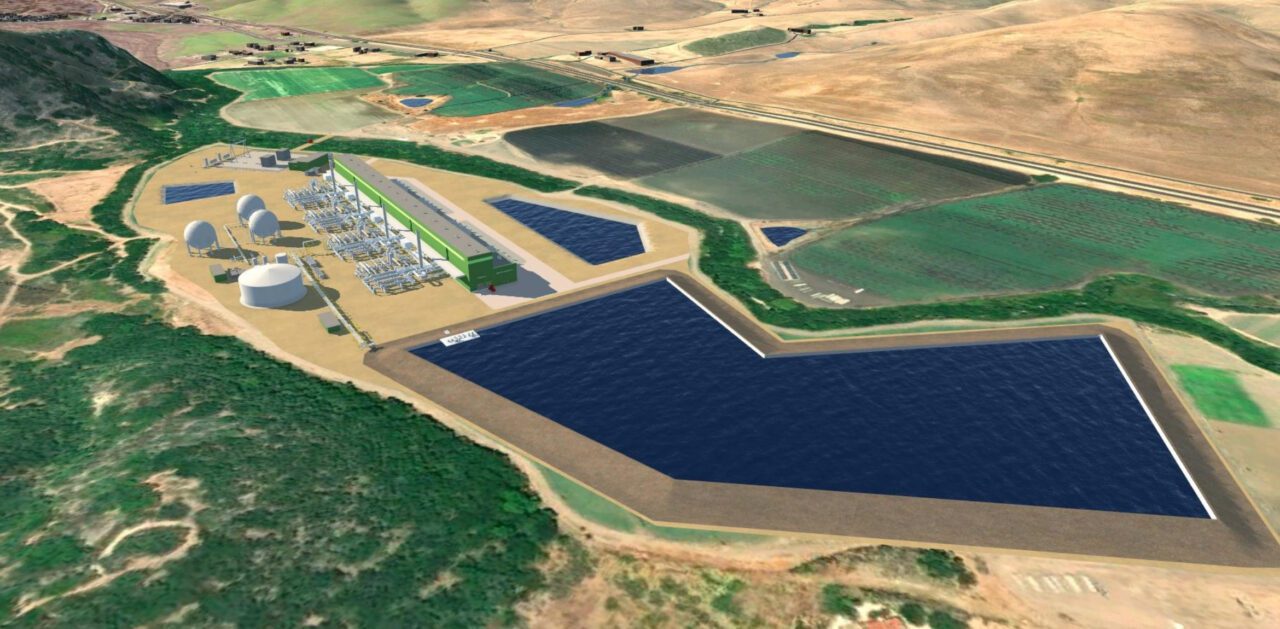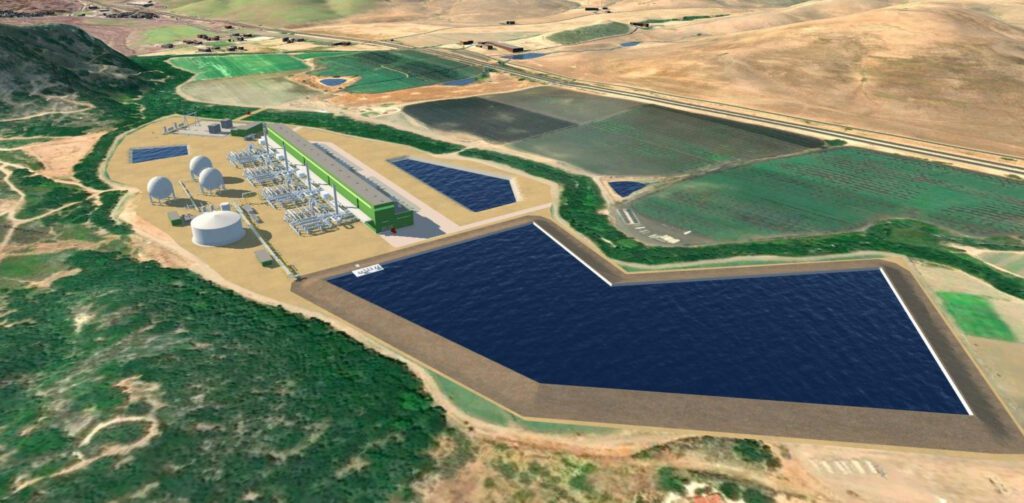California 3,200-MWh CAES Project Proposed for Grid Stability After Diablo Canyon Nuclear Plant Retires

Hydrostor, developer of a 400-MW, 8-hour long-duration advanced compressed air energy storage (A-CAES) facility, has filed an application for certification (AFC) with the California Energy Commission (CEC) for its first project in the state, envisioning its commercial operation as early as 2026.
If the 3,200-MWh Pecho Energy Storage Center is built as planned in San Luis Obispo County, California, it will serve as a spinning reserve that can provide peaking power for local contingencies. But the unique project will also provide non-fossil fuel synchronous condenser voltage support services that will be essential to provide reliability support and stability to the California Independent System Operator (CAISO) grid while facilitating the integration of intermittent renewable energy sources into the electrical grid. These services, along with project development and construction jobs, will be especially crucial for San Luis Obispo County after the nearby 2.2-GW Diablo Canyon nuclear plant retires in 2025, Hydrostor said in a statement as it submitted its application to the CEC on Nov. 23.
Pecho's ability to flexibly deliver 400 MW of stored energy, every hour, for eight hours without relying on fossil fuels or other polluting resources would make the Project one of California's largest single new energy storage facilities," the company said. Pecho would surpass all existing battery energy storage projects in California in terms of both megawatts delivered and duration of generation, with an expected capital investment of approximately $800 million."
Storing Energy in a 2,000-Foot-Deep CavernAccording to the filing, Pecho will be built, owned, and operated by Pecho LD Energy Storage, a joint venture between Toronto-based Hydrostor, and Paris-based financier and asset manager Meridiam Infrastructure Partners. The project will be located on an approximately 80-acre site within the southern portion of an approximately 300-acre parcel owned by Morro Bay Ranch Limited Partnership, amid undulating green hills within view of the Pacific Ocean. The application notes, however, that Pecho LD Energy Storage is still negotiating a long-term lease with Morro Bay Ranch to use the Pecho project site.
 The $800 million Pecho Energy Storage Center project's ability to flexibly deliver 400 MW/3,200 MWh will make it one of California's largest single new energy storage facilities. The project would also be larger than all existing battery energy storage projects in California, both in terms of capacity and duration. Courtesy: Hydrostor
The $800 million Pecho Energy Storage Center project's ability to flexibly deliver 400 MW/3,200 MWh will make it one of California's largest single new energy storage facilities. The project would also be larger than all existing battery energy storage projects in California, both in terms of capacity and duration. Courtesy: Hydrostor
Hydrostor says construction of the project will entail excavating a compressed-air cavern about 2,000 feet deep underground using conventional mining techniques. Four Hydrostor all-electric air compressor trains and four 100-MW air-driven power turbine generators will be housed inside a massive turbine hall and compressor building about 100 feet tall, 65 feet wide, and 1,075 feet long. Developers will also build a 27-acre by 40-foot-deep hydrostatic compensation surface reservoir, with about 50-foot-high earthen berms. Finally, a sealed air conduit would be installed to facilitate cyclic injection/storage of compressed air and release of compressed air for power generation," it said.
A 50-Year Life, a 14-Hour Charge, and 24-7 OperationOver its 50-year lifetime, Pecho will operate on a 24/365 basis, with an expected annual capacity factor of up to 85%. Its operating process involves cycling between two modes. During its charging mode"-which is designed to last up to 14 hours-it will draw off-peak power from the grid to run the all-electric air compressors.
That compressed air will then be injected into the purpose-built" water-filled subterranean cavern where it will displace the cavern water upward into the hydrostatically compensating reservoir. The heat generated during the compression process will also be recovered to heat water in a closed-loop thermal storage system, with the hot water stored in aboveground spherical tanks. Upon completion of the charging cycle, the system will be available to generate electricity," Hydrostor said.
During its discharge mode," water from the hydrostatically compensating reservoir will be allowed to flow down into the subterranean cavern, displacing the stored compressed air, which will be expanded in power turbines to generate electricity for up to eight or more hours. Hot water recovered and stored in the aboveground spherical tanks during the charging cycle will be used to reheat the expanding air at intermediate turbine stages to facilitate higher efficiency power generation.
During the compression process, water vapor entrained in the compressed air will be condensed and recycled. Dry air exiting the power turbines will be discharged to the atmosphere through four stacks, one serving each power generation train. Fossil fuel will not be required to operate the Pecho project during normal operation," the company underscored.
Sensible' Thermal Energy Storage for Long-Term Grid StabilityThe adiabatic process essentially leverages sensible thermal energy storage to increase the overall efficiency, Hydrostor explained, noting-without elaboration-that the technology will provide superior round-trip thermodynamic efficiency." The cavern's hydrostatic compensation is used to maintain the system at a constant pressure during operation," it said. When electricity is needed, the hydrostatic pressure forces air to the surface where it is recombined with the stored heat and expanded through a turbine," it said.
That's a major advantage when compared to California's current energy storage procurement. As of October 2021, CAISO had 1.9 GW of installed battery storage and is on track to reach 3 GW by the end of this year. But recognizing a vital role long-duration energy storage will play to maintain grid reliability, flexibility, and resilience, the California Public Utilities Commission in June 2021 adopted a decision that directed the procurement of 1 GW of long-duration storage to be online between 2026 and 2028.
As Hydrostor noted on Tuesday, Pecho not only proposes improved technological diversity" and non-combustible energy storage," but when compared to battery storage, A-CAES offers minimal residual hazardous waste at asset retirement, long term commercial lifespan of 30 years or greater, and non-degrading energy storage."
VIDEO: Hydrostor's advanced compressed air energy storage (A-CAES) system works by converting excess grid energy into compressed air. That compressed air is then sent into purpose-built underground caverns, where it displaces water to create stored energy in the form of pressurized air. The compressed air can then be run through an air turbine to generate electricity, with no additional fuels, when the grid needs it. Courtesy: Hydrostor
Hydrostor on Tuesday said Pecho will interconnect to an existing 3.4-mile 230-kV transmission line interconnected at Pacific Gas and Electric's (PG&E's) Morro Bay Switching Station. The AFC, however, notes that the project may consider interconnecting at the CAISO-controlled Diablo Canyon Substation. Both are major substations in the central California coastal region," but it will depend on whether adequate interconnection capacity exists at a feasible cost."
Either connection would help offset the loss of generation from Diablo Canyon Nuclear Power Plant decommissioning, and to facilitate the integration of onshore and offshore renewable energy development," the application notes. Notably, the project also involves connecting two diesel-fired emergency black-start capable backup generators of up to 5 MW to support critical facility load in the event of a power interruption.
Hydrostor's Growing A-CAES Project PipelineHydrostor CEO Curtis VanWalleghem on Tuesday said the AFC filing marks the first of many important milestones in the implementation of Hydrostor's commitment to helping California meet its recognized long-duration energy storage needs."
Since its milestone completion of its Toronto Island Demonstration Facility in 2015, Hydrostor opened up its 1.75-MW/10-MWh Goderich site in Ontario to commercial service in 2019. Along with Pecho, its slate of near-term projects for California include the even larger 500-MW/4,000-MWh Gem A-CAES project, which is under active development in Kern County, California, and expected to be online in 2026. Hydrostor is meanwhile developing the 200-MW/1,600-MWh Broken Hill Energy Storage Centre with utility Energy Estate to support reliability in New South Wales, Australia. That project could come online in 2025.
The Pecho AFC involves a standard 12-month-long licensing process the CEC uses for most proposed power plant projects that would fall under its jurisdiction. If approved, Pecho's construction could kick off in the second quarter of 2023. Pre-operational testing of the power plant is expected to begin by third quarter 2027, and full-scale commercial operation is expected to begin by fourth quarter 2027," the application says.
State law designates the CEC to serve as the lead agency for California Environmental Quality Act review and permitting of the facility, Hydrostor noted. Pecho's filing of its AFC with the CEC will initiate the very thorough and comprehensive public review process. The County of San Luis Obispo and numerous other local, state, and federal agencies, as well as interested community stakeholders, will be closely involved in the CEC-led review."
-Sonal Patelis a POWER senior associate editor (@sonalcpatel,@POWERmagazine).
The post California 3,200-MWh CAES Project Proposed for Grid Stability After Diablo Canyon Nuclear Plant Retires appeared first on POWER Magazine.